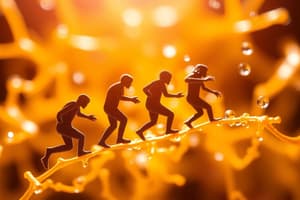Podcast
Questions and Answers
What is the concept of evolution?
What is the concept of evolution?
The process by which different kinds of living organisms are believed to have developed from earlier forms during the history of the earth.
Who proposed the theory of evolution based on survival of the fittest?
Who proposed the theory of evolution based on survival of the fittest?
- Charles Darwin (correct)
- Matthias Jakob Schleiden
- Theodor Schwann
- Jean Baptiste Lamarck
What are the main characteristics of living organisms?
What are the main characteristics of living organisms?
Made of cells, require energy (food), reproduce, maintain homeostasis, organized, respond to environment, grow and develop, exchange materials with surroundings.
Prokaryotic organisms are more complex than eukaryotic organisms.
Prokaryotic organisms are more complex than eukaryotic organisms.
What three primary structures are present in prokaryotic cells?
What three primary structures are present in prokaryotic cells?
What is cell theory?
What is cell theory?
Who formulated the cell theory?
Who formulated the cell theory?
Plants, fungi, and animals are examples of ______ cells.
Plants, fungi, and animals are examples of ______ cells.
What is the function of the nucleus in a cell?
What is the function of the nucleus in a cell?
The cytoplasm is found in all cells and allows for chemical reactions to take place.
The cytoplasm is found in all cells and allows for chemical reactions to take place.
Match the terms with their descriptions:
Match the terms with their descriptions:
Flashcards are hidden until you start studying
Study Notes
Introduction to Cell Biology and Evolution
- Evolution describes the process through which diverse living organisms develop from earlier forms throughout Earth's history.
- Key figures:
- Jean Baptiste Lamarck: Advocated for spontaneous generation based on environmental needs and mutations (1801).
- Charles Darwin: Proposed the concept of "survival of the fittest" to explain evolutionary changes (1859).
Cell Theory
- Formulated by Theodor Schwann and Matthias Schleiden in 1838.
- States that:
- All living things consist of cells.
- Cells function as the basic unit of structure and function in organisms.
- New cells arise from the division of existing cells.
Characteristics of Living Organisms
- Composed of cells.
- Require energy, typically in the form of food.
- Capable of reproduction.
- Maintain homeostasis to regulate internal conditions.
- Organization and response to environmental changes.
- Growth and development through cell differentiation.
- Exchange materials with surroundings (e.g., water, waste, gases).
Cell Structure
- Cells are the smallest units of life.
- Key functions of cells include:
- Metabolism.
- Respiration.
- Reproduction (via meiosis and mitosis).
- Energy production and information storage.
Prokaryotic vs. Eukaryotic Cells
-
Prokaryotes:
- Lack a nucleus and membrane-bound organelles.
- Genetic material located in a nucleoid region.
- Surrounded by a cell membrane and a peptidoglycan cell wall.
- Contain ribosomes for protein synthesis.
-
Eukaryotes:
- Have a nucleus and membrane-bound organelles.
- Include organisms from the kingdoms of protists, fungi, plants, and animals.
- More complex structure compared to prokaryotes.
Organelles and Their Functions
- Organelles are microscopic structures found within cells that perform specific tasks.
- Can be membrane-bound (e.g., nucleus, mitochondria) or non-membrane-bound (e.g., ribosomes).
Cell Membrane
- Composed of a double layer of phospholipids with embedded proteins.
- Acts as a barrier, controlling the entry and exit of substances.
- Plays a vital role in maintaining homeostasis within the cell.
Cytoplasm
- A jelly-like substance within the cell membrane.
- Provides a medium for biochemical reactions and houses organelles to perform specialized functions.
The Nucleus
- The control center of the cell, overseeing normal cellular activities.
- Houses DNA organized into chromosomes.
- Surrounded by a nuclear envelope that protects its contents.
Whittaker’s Kingdom Classification
- Classifies living organisms into five kingdoms based on cellular structure:
- Prokaryotic kingdom comprising unicellular organisms like bacteria.
- Other kingdoms consist of eukaryotic organisms that contain true nuclei and organelles.
Studying That Suits You
Use AI to generate personalized quizzes and flashcards to suit your learning preferences.




